SlashGear Science Week In Review - April 23rd, 2011
This week in Science, a hybrid car that was green before green was cool, the possible future of solar energy, a couple of interesting concrete concepts, and a whole lot of medical innovations. Oh, and robots. One that takes a licking and keeps on ticking, and others that can go where no man wants to go.Earth day was this week, so we have featured some green concepts and innovations. We always like seeing more efficient ways of doing things, and a road that powers its own lighting and traffic systems is a great example of that. But first, the world's first hybrid car.
World's First Hybrid Car
If you had to quickly think of a hybrid car, the Prius would probably be the first vehicle that would come to mind. But the very first functional hybrid car was the Porsche Semper Vivus, built way back in 1900. Back then, the battle between electric and combustion engines had not yet been won, and nobody knew for sure which way things would go.
Porsche has rolled out an exact replica of the very first hybrid car, which was painstakingly recreated by a dedicated hobbyist, and gave some journalists a ride around in it. The Semper Vivus had two electric motors, one on each front wheel, and two combustion motors which power the car and also charge the electric motors. Pretty cool! You can check out the action in the videos below.
Solar magnetic energy, the future of solar?
Researchers at the University of Michigan have discovered a new property of light that allows them to harness its magnetic attributes.

Electromagnetism is a classically unified force, the relationship between light and magnetism is well known, but the magnetic component was thought to be weak enough that it could be safely ignored. Stephen Rand, a professor at UMich, said, "You could stare at the equations of motion all day and you will not see this possibility. We've all been taught that this doesn't happen. It's a very odd interaction. That's why it's been overlooked for more than 100 years."
This could lead to a new kind of solar cell without semiconductors and without absorption to produce charge separation," Rand said. "In solar cells, the light goes into a material, gets absorbed and creates heat. Here, we expect to have a very low heat load. Instead of the light being absorbed, energy is stored in the magnetic moment. Intense magnetization can be induced by intense light and then it is ultimately capable of providing a capacitive power source."
Using this magnetic property of light would only require glass, for lenses to focus the light and fiber to guide it. Transparent ceramics are also a possibility. This would be much cheaper than solar cells which are expensive to produce. This could be the breakthrough that makes solar power cheap enough for widespread adoption.
Sidewalk, Heal Thyself
We use concrete for so many things, and it is a great building material: inexpensive, durable, easy to shape. But it can develop micro cracks very quickly when under tension, sometimes in a matter of weeks. Once that happens, water can seep in and the deterioration process begins.
Researchers in Belgium at Delft University have a great solution to this problem: bacteria. They say that they will be able to commercialize a "biological concrete" within two to four years that can heal itself in much the same way our bodies do.
The concrete uses a specially selected bacteria from the genus Bacillus, with a combination of calcium lactate, nitrogen and phosphorus to create a healing agent inside the concrete. If these agents are not exposed to water, they can remain dormant inside the concrete for centuries. But as soon as water seeps in, the bacteria spores germinate and feed on the calcium lactate. This process consumes oxygen, which converts the calcium lactate into limestone that solidifies and seals the surface. As the oxygen is removed, this also protects the steel reinforcement.
'We use clay pellets that are around 2-4mm wide to make sure that the agents are not activated during the mixing process,' said Dr Henk Jonkers. 'The problem with this is we have to use relatively high volumes of this porous aggregate within the concrete mix. As a result, you gain self-healing but you lose the strength of the concrete.'
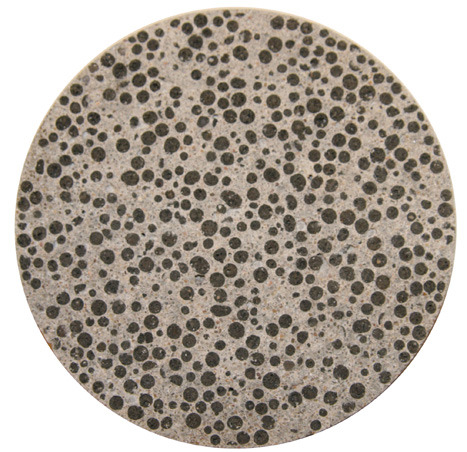
In fact, the concrete becomes about 25 percent weaker, which is far too much for applications that require high compressive strength. Jonkers is working on using a compressed powder rather than the pellets, that will hold the self-healing agent in less than one percent of the volume of the concrete.
Researchers at Ghent University are taking a different approach, using a hollow glass capsule to contain the healing agents, which they make out of Bacillus sphaericus and urea. The capsules range from 0.8 to 4mm in diameter. If the concrete cracks, the capsules break, releasing the healing agent. This method retains the strength of the concrete, but sounds more expensive.
Bacteria struggle to fill cracks larger than 300mm. Synthetic agents can fill larger cracks, but they can also make the concrete brittle, and are not sustainable. The scientists hope to find a way to improve their organic healing method, and are already working on a new solution that would make the cost of the self-healing concrete (which now is double the cost of traditional material) on par with regular concrete.
If this material is able to be made commercially, it could save huge amounts of money on road and other infrastructure repairs. 50 percent of Europe's annual construction budget is spent on rehabilitation and repair of existing structures.
It's a very green concept, as it is sustainable and also would prolong the life of a building material, so that less would be chucked into landfills.
Solar Roads
And in another case of the Dutch doing crazy things with concrete, how about road with solar panels built in?

The project is called the Solaroad, and was developed by the Dutch research firm TNO. Here's the idea: a layer of concrete forms the road, a centimeter thick layer of crystalline silicon solar cells is laid on top, and then the whole thing is covered by a layer of toughened glass. Sounds slippery, and expensive. But let's continue.
The road could produce as much as 50kWh per square meter per year, which could power street lighting, traffic systems, and households. The idea is still in development, and it would be first applied to bike lanes. The first Solaroad is scheduled for installation next year, and then they hope to study it and expand the roads throughout the country. Would this ever make it to the US? Who knows, but probably not in the near future. It will be interesting to see how it works out for the Dutch.
Medical Innovations: Artificial Pancreas, Hand Transplant, Bionic Leg, and an App for Knee Surgery
Artificial pancreas
The pancreas is such an incredibly complex organ, producing needed horomones for the body such as insulin, and also aiding in digestion. It is part of both the endocrine and digestive system. The thought of actually producing an artificial pancreas is staggering. So it isn't too surprising that this artificial pancreas really isn't one. It doesn't actually replace a person's pancreas. It only fulfills one of the pancreas' functions, supplying insulin.

The system has three parts: a small subcutaneous patch to monitor blood glucose levels, sending the results via radio frequency to a small computer that calculates the correct insulin dose, and an insulin pump that delivers the dosage.
"The system has the potential to improve the safety and effectiveness of insulin delivery and may allow more flexible lifestyles in the future," said Dr Roman Hovorka of Cambridge University, who led the study. He said that the system could be exceptionally useful at night, when dangerous blood sugar drops often happen.
There are currently systems that allow a patient to wear a patch that monitors their blood sugar, and a small, cell phone size insulin pump to deliver a steady dose throughout the day. But these still require input from a clinician or a patient. This system is closed-loop, intended to be completely autonomous, just like an organ. It was tested by 12 diabetics overnight, after consuming a large meal with carbohydrates and alcohol (sounds like a joke: 12 diabetics walk into a bar...). The patients had a 22 percent improvement in keeping blood-glucose levels in a safe range, and the incidence of low blood-glucose levels was cut in half.
This technology would be a great improvement in the quality of life for many diabetics. Now, to make it widely available, and affordable.
Hand Transplant
In another amazing medical accomplishment, a woman from Yuba City, California recieved a hand transplant. Emily Fennell is a single mom, and lost her right hand in a car accident in 2006. She had adapted to using her left hand for daily tasks, and had a prosthesis, but it was less than satisfactory. So, in an amazing 14 1/2 hour operation at UCLA Medical Center, which required a team of 20, her bones, blood vessels, nerves and tendons were connected to the donated hand.
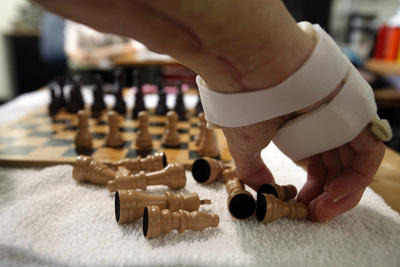
This is the 13th such transplant in the US, and the first at UCLA. Fennell will have to take medication for the rest of her life to prevent rejection of the hand, but with some intensive rehabilitation (she is spending more than 8 hours a day in therapy now), she will be able to regain significant use of the hand. It will never be fully functional but she will regain 60 percent of function. She was able to move her new fingers soon after the surgery, but still has no feeling in the hand. The surgery cost $800,000, but it was experimental, so she did not have to pay.
A surgeon who has performed the transplant surgery on another patient, Dr. Linda Cendales, described the function of a transplanted hand this way, "They will never have a normal hand. But they do recover enough sensation to differentiate between temperatures, and rough and smooth surfaces." They can open doors, tie shoes and turn pages. Not a bad deal, all things considered.
Bionic Leg
There have been great advances in the use of prosthetic limbs, making them lighter, more comfortable, and easier to move. But many of the current prosthetics are operated manually, by the person swinging their leg out to step forward. Scientists at the Rehabilitation Institute of Chicago's Center for Bionic Medicine are working on a project to create a robotic prosthesis that would be controlled by the person's own nervous system, and powered so that it can move on its own.
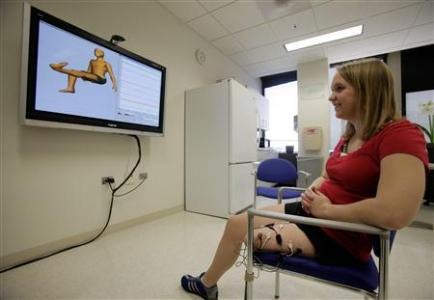
One patient that is testing the new technology is Hailey Daniswicz, 20, who lost her lower leg to bone cancer in 2005. Daniswicz is training a computer avatar to recognize slight movements in her thigh. She has electrodes attached to nine different muscles in her thigh, and can see her progress on the screen as she flexes and moves her muscles. The computer begins to recognize the intent of the user over time.
She is participating in a clinical trial sponsored by the U.S. Army using electromyography (electrical signals produced by muscles) and pattern recognition computer software to control the next generation of robotic limbs. She will eventually be fitted with a robotic limb.
"We're really integrating the machine with the person," said Levi Hargrove, a research scientist at the Rehabilitation Institute of Chicago's Center for Bionic Medicine who is leading the project. The researchers have already developed prosthetic arms that use nerve impulses to operate. A leg is the next step. It is too early to say now when these would be available, but we are closer than we've ever been before.
Knee Surgery? There's an app for that.
Is there anything you can't do with an app? There's even an app that assists with knee surgery. The app is called DASH and is developed to work on an iPod touch to aid doctors through complex knee and hip replacement surgery. There's of course more equipment needed than just the iPod touch, but the device is an integral part of the system.
Doctors at Breach Candy hospital in Mumbai successfully performed three knee replacement surgeries using the new technology. The system involves slipping the iPod touch into a case that has precision measuring instruments attached to it. The surgeon then positions the iPod touch to read the data from the high-resolution screen to accurately mark spots to cut and properly align new components into the joint.

"Accuracy in positioning the new joint is what decides how well the patient walks post-surgery, how much the knee bends, and even how long it lasts," said Dr. Arun Mullaji, who demoed the new system.
There are already precision technologies that help with the complexity of knee surgery, but they are bulky and complicated to operate. The DASH software along with the use of an iPod touch makes the process more portable, intuitive, and affordable. The system was developed by Smith & Nephew along with Brainlab and already has a CE certification for Europe. It is waiting for approval in the U.S. A free demo of the app is available for download called DASH Learn.
See the video of how it is done here:
And Now For The Robots...
SARCOS: A robot you can push around
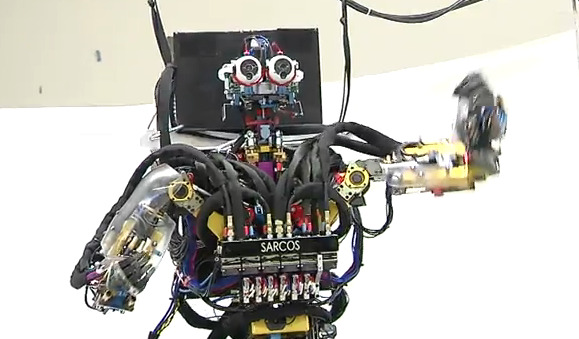
The Sarcos is a full body humanoid robot that stands and balances on its own two feet with movements that are fluid thanks to the use of hydraulic actuators. Ben Stephens, a Ph.D. research student at Carnegie Mellon, works with Sarcos to develop its balancing abilities. In the first video below you will see him demonstrating Sarcos by having it perform a dance that was programmed from recording human movement via motion capture.
The second video actually shows Sarcos getting pushed with a stick and being able to step forward to adjust its balance without falling over. That's a good skill to have considering Sarcos is probably not cheap nor lightweight and could cause both monetary and physical damage. What's interesting in both videos is that Sarcos is not just playing back programmed joint movements, but is actively adjusting balance throughout each movement.
Now, if they can make him cordless, and give him some skin, that guy is going to be really freaky.
iRobots in Fukushima
On Sunday April 17th, iRobot packbots entered the Fukushima Daiichi reactor building 3 to explore parts of the plant that have been closed to people since the facility was evacuated. Japanese nuclear workers were entering some locations in the plant just after the disaster, but now they've mostly pulled back to safe locations. The shorter term radiation doses were relatively safe, but at sustained elevated levels the threat of damage grows. The repair efforts continue with support from a number of robotic helpers.
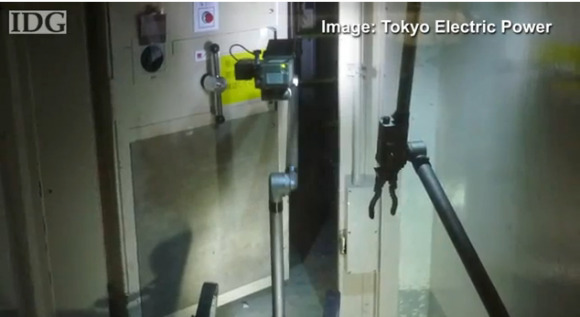
The packbots had the important job of taking radiation and temperature readings from inside the rooms that had been sealed since the disaster. TEPco has not released these findings to the public yet, but rest assured, you don't want to go in there. The bots also feature a video camera with a live-feed to operators at a safe location. The iRobot packbots are notable for their use in US Military operations in Iraq and Afganistan as bomb defusal bots.
See the video of the packbots entering the plant:
That's a wrap for SlashGear Science week in review. Thanks for reading, and see you next week. We always appreciate your feedback, so feel free to send in your suggestions, or leave them in the comments.
